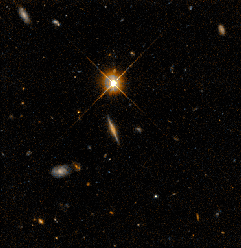Hubble Law
The Hubble constant H is one of the most important numbers in
cosmology
because it may be used to estimate the size and
age of the Universe.
It indicates the rate at which the universe
is expanding. Although the Hubble "constant" is not really constant because it
changes with time (and therefore should probably more properly be called the "Hubble
parameter"). The Hubble constant is often
written with a subscript "0" to denote explicitly
that it is the value at the present time, but
we shall not do so.

FIGURE: The image to the right,
taken with the
Wide-Field and
Planetary Camera (WFPC2) of the
Hubble Space Telescope
shows many galaxies
(most of the fuzzy patches are galaxies containing billions of stars) that are
billions of light years away and are receding from us at high velocities.
Click on the image to get a larger version (WARNING: 300 kB).
The Hubble Expansion Law
In 1929, Edwin Hubble announced that
almost all galaxies appeared to be moving away from us. This
phenomenon was observed as a
redshift of a galaxy's spectrum.
This redshift appeared to have a
larger displacement for faint, presumably further, galaxies. Hence, the
farther a galaxy, the faster it is receding from Earth.
The Hubble constant is given by
H = v/d
where v is the galaxy's radial outward velocity,
d is the galaxy's distance from earth, and H
is the current value of the Hubble constant.

